Neon tetras may only grow to be about 1 to 2 inches long…but what they lack in size, they make up for in beauty and personality!
Neon tetras have shimmering silvery-blue bodies with a brilliant red stripe. They prefer to swim in large schools of around 15-20, so you’ll have to buy several at once.
Neon tetras also live a fairly long life, at least by aquarium fish standards. They can easily live for 5 years in the right conditions.
This guide explores a few of our favorite neon tetra tank mates along with their unique care needs.
10 Awesome Neon Tetra Tank Mates
Once you’re all set up with your school, it’s time to pick out some cool neon tetra tank mates to share the aquatic world you’ve created.
Take care to curate your tank’s inhabitants so you end up with a happy, healthy community that’s easy to care for and lots of fun to watch.
Guppies
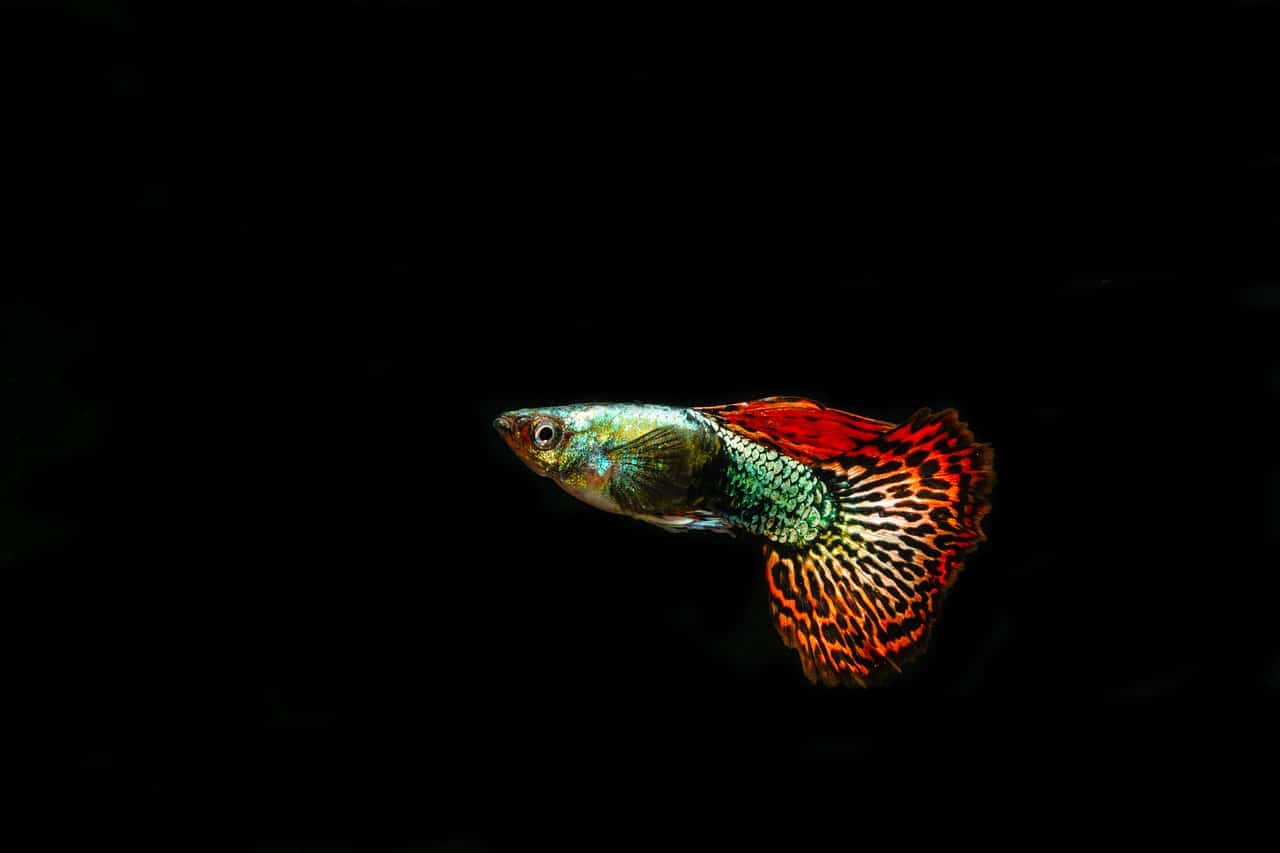
- Size: ½ inch – 2 ½ inches
- Temperature: 74 – 82 degrees Fahrenheit
- Difficulty Level: Easy
When you think of cool aquarium fish, “guppy” might not be the first thing to pop into your head. But, have you really sat and looked at one? Guppies are gorgeous! With iridescent scales that shimmer with rainbow colors, guppies are actually quite beautiful. Guppies also have an exotic and vibrantly colored tail fin that fans out in a flambouyant display.
Guppies come in a virtually endless array of colors. Blue, orange, green, silver, and just about any color or combination you can imagine. Guppies enjoy schooling, so add several to the tank at once. Generally, you should have double the number of males as females in your guppy group.
Gravel or rock substrates are good for guppies; sand is not ideal. Like most fish, guppies need hiding spots. Plants, rocks and other tank “furniture” can provide this for them.
Guppies are usually good neighbors to their tank mates, never provoking fights or otherwise displaying aggressive behavior. However, guppies may nip at long-finned fish such as Angelfish and Longfin tetras.
Guppies love to eat all the things, so give them a variety of plant and animal food.
Gorgeous guppies come in lots of varieties. To name a few:
- Snakeskin
- Tuxedo
- Leopard
- Lace
- Cobra
- Mosaic
African Dwarf Frogs
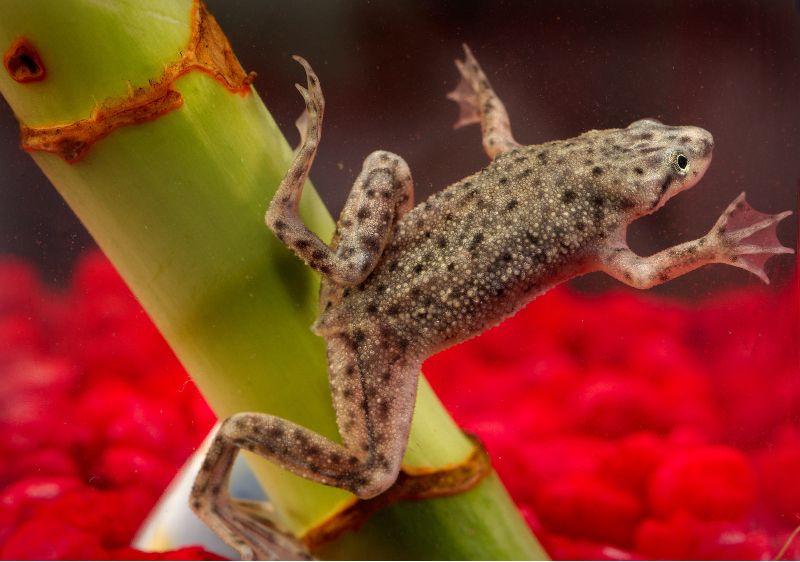
- Size: 1 – 3 inches
- Temperature: 72 – 82 degrees Fahrenheit
- Difficulty Level: Easy
Frogs might seem to be an unlikely choice for a fish aquarium, but African dwarf frogs are entirely aquatic and do not need dry land in their tank. Interestingly, they do have lungs but can get all the air they need from the water’s surface.
Frogs tend to make more waste than fish. Be sure to get a good quality filter that’s powerful enough to keep up.
Frogs are super sensitive to even the mildest soaps and detergents, so just don’t use them on anything you put in a frog tank. Gravel substrate is usually the best pick for aquatic frogs.
Frogs enjoy resting on plant leaves as they explore their aquarium, so make sure you add a couple of large-leafed varieties. Real or fake plants are fine, just make sure you’re using something that’s safe for all your tank’s residents.
A warning about keeping African dwarf frogs in your fish aquarium: Hungry frogs may try to make a snack out of smaller fish. To minimize the risk of this happening, be timely and consistent in feeding your frogs!
African Dwarf frogs are meat-eaters. They love frozen bloodworms and brine shrimp. Sinking pellets are also recommended, since frogs mostly hang out around the lower portions of the tank. When you feed frogs, watch to make sure they actually eat their food. Fish move at a much faster rate than frogs, and it’s not unheard of for frogs to have their dinner snatched from under their noses. It can help to distract your fish with their own feeding on the other side of the tank.
Angelfish
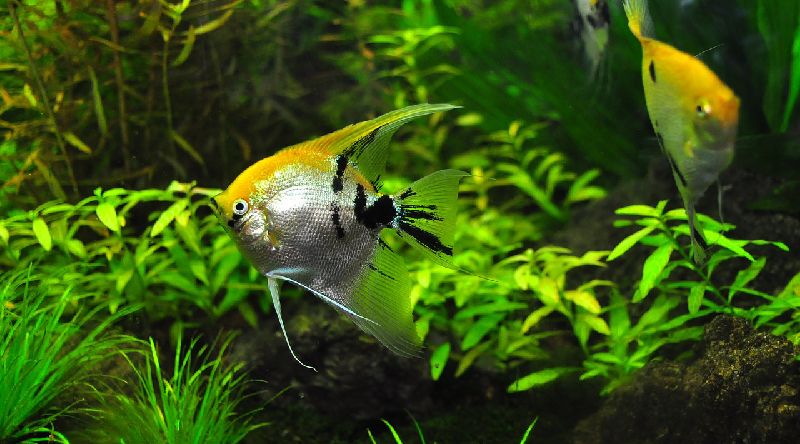
- Size: Up to 6 inches
- Temperature: 78 – 84 degrees Fahrenheit
- Difficulty Level: Medium
Elegant angelfish are always a beautiful addition to the aquarium. Their long, trailing fins give a dramatic performance for onlookers as they swim about the tank. Normal or wild type Angelfish are silver-colored with dark vertical striping. Like many favorite fish, though, several interesting varieties have been developed. The following are just a few of the more popular ones you might come across.
- Zebra
- Albino
- Marble
- Leopard
- Veil
Angelfish need a large aquarium that is tall enough to accommodate those supersized fins. Angels aren’t really into fighting but are not above eating smaller fish in the aquarium. For this reason, don’t place them in the same tank with baby fish.
Angelfish will eat packaged food in flake or pellet form.They also enjoy live or frozen animal protein; giving them some frozen bloodworms and brine shrimp once in a while will be a most welcomed treat.
You can see that Angelfish like their water on the warm side. Their temperature requirements overlap with those of neon tetras. Just make sure that’s true with any other creatures you want to add to the habitat.
As for substrate, Angelfish are pretty versatile. Pebbles and gravel both make good choices. Include features such as driftwood, rocks, and large leafy plants to give them plenty of suitable hiding spots.
Mollies
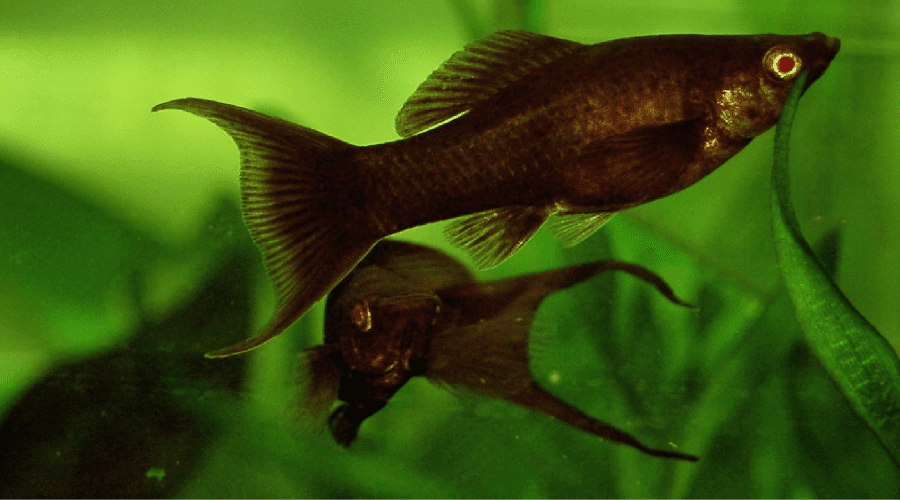
- Size: 3-6 inches
- Temperature: 70 – 85 degrees Fahrenheit
- Difficulty Level: Easy
Everybody loves Mollies. They’re small, cute, and laid-back. They won’t stir up any drama in your fish tank, and they don’t demand a huge amount of special care to thrive. Healthy Mollies can live for up to 5 years.
Mollies will tolerate change better than a lot of small aquarium fish; they can manage in a broad range of temperatures. They are also enthusiastic eaters. Molly flake food is fine, but it’s better if you also supplement with fresh vegetables (cut into small chunks, of course) and live or frozen animal protein.
Most Molly keepers use sand or gravel for substrate. These sociable fish like to live in aquariums that contain at least some vegetation (fake plants are totally fine, just make sure they’re clean and don’t have any sharp edges or small parts that could be accidentally ingested.
Loaches
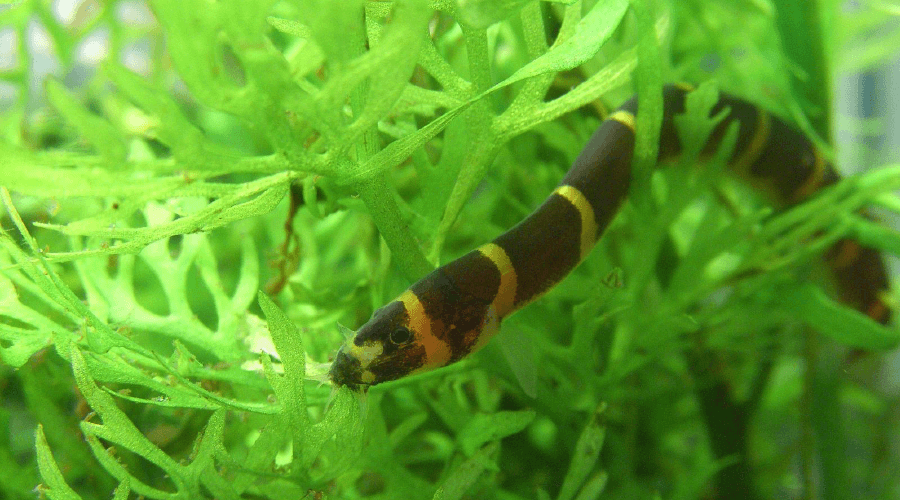
- Size: 4 – 12 inches, depending on variety
- Temperature: 60 – 77 degrees Fahrenheit
- Difficulty Level: Easy
Loaches are another type of scavenger fish, making their way around the aquarium eating up all the bits of algae and debris. There are quite a few great varieties of loaches to choose from
Loaches prefer the company of others and won’t be as enthusiastic if they’re kept alone. They’re friendly and won’t start any trouble with tankmates.
Loaches need caves or hides to duck into, and they like sand or gravel for substrate. Loaches will eat algae and microorganisms, but it’s often necessary to supplement their diet with algae flakes or other prepared food.
Cardinal Tetras
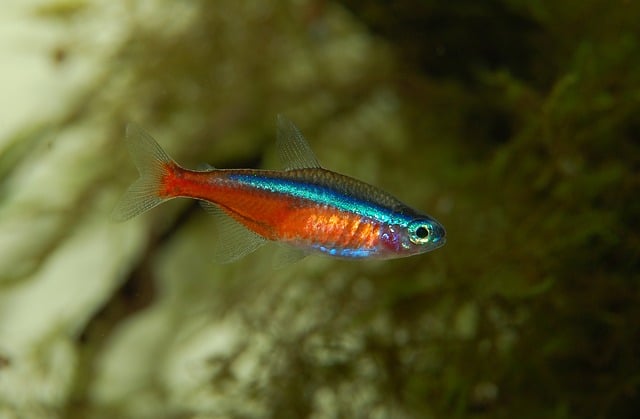
- Size: About 2 inches
- Temperature: 79 – 82 degrees Fahrenheit
- Difficulty Level: Easy to Medium
Although they are sometimes wrongly classified as Neon tetras, Cardinal tetras are their own distinct variety of tetra. Cardinals share that distinctive red coloring with Neons, but it’s easy to spot the difference between the two. Cardinal tetra stripes run the full length of the body, while Neon tetra stripes end about halfway down.
Cardinal tetras aren’t that big on having lots of plants in their habitat, although they do enjoy driftwood and other features that give them cover when they’re not feeling sociable. Keep in mind that they also need plenty of space to swim around, so ensure there are some open areas in the tank. Given the room, these little fish will expend lots of energy entertaining you with their enthusiastic play.
Cardinal tetras are avid eaters and will happily dine on a wide variety of food. They need a nutritionally dense diet, so supplement flake or pellet food with fresh or frozen snacks.
Cardinal tetras get along well with others and prefer living in small schools. They’re small, so keep this in mind as you select tankmates. Much larger fish might mistake some tiny Cardinal tetra for its afternoon feeding.
Ghost Shrimp
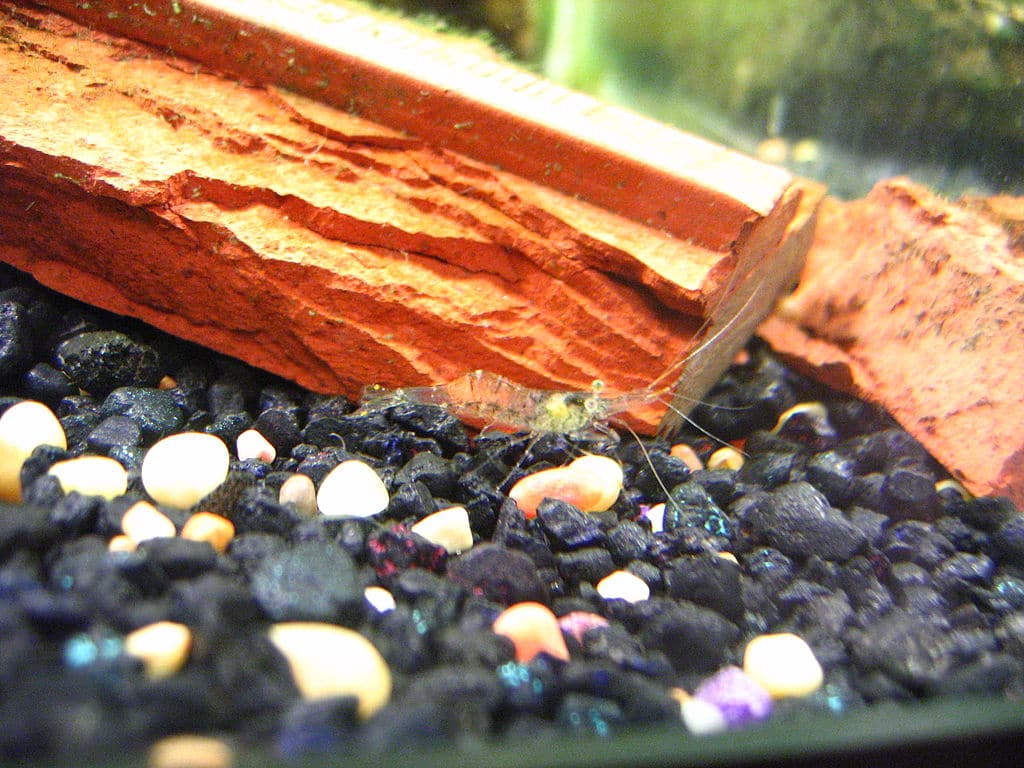
- Size: 1 – 2 inches
- Temperature: 72 – 82 degrees Fahrenheit
- Difficulty Level: Easy
Tiny Ghost shrimp (a.k.a. Glass shrimp) can add some serious personality to your tank. The name comes from their transparent shell. This see-through appearance is actually a defense mechanism, developed to help them hide from predators. It also makes Ghost shrimp very popular among hobbyists – because it’s undeniably cool to be able to see inside your crustaceans.
Ghost shrimp are very small. So small that they’re often sold as bait! Natural scavengers, Ghosts will gobble up the algae that accumulates around the tank. Actually, they’ll eat just about anything and they’re pretty clever when it comes to acquiring food. Ghost shrimp are experts at positioning themselves in just the right spot to snatch food away the second it’s placed in the tank. Remember this when it’s feeding time and be sure everyone gets their fair share.
Being so small in stature, ghost shrimp feel more secure when they have plants and rocks to hide behind. Be careful about roommates; larger animals may pick on the peaceful ghost shrimp.
Delicate Ghost shrimp don’t live very long, so keep this in mind when deciding if they’re right for your tank. At best, they can live for about one year in a home aquarium.
Corydoras Catfish
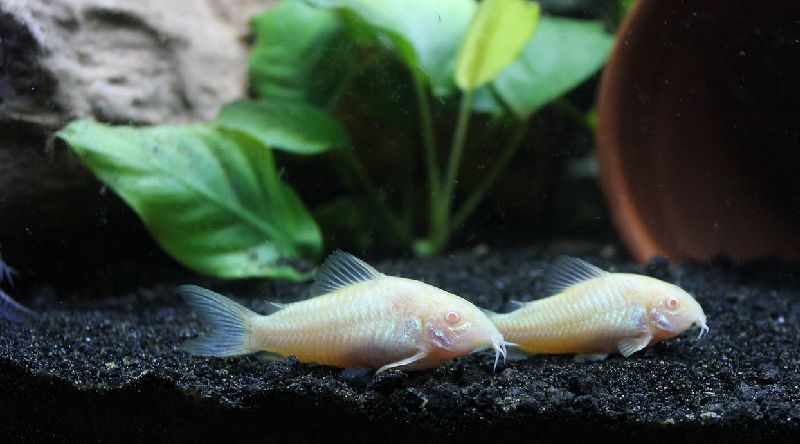
- Size: 1 – 3 inches
- Temperature: 70 – 80 degrees Fahrenheit
- Difficulty Level: Easy
Corydoras catfish, or Cory Cats for short, make a solid choice for a community tank. They’re an eye-catching attraction in any aquarium, with their tiny “whiskers” and endearing personalities. Corys keep to themselves and generally don’t make trouble in your little habitat. They’re quite small, and only grow to be a few inches long.
Another notable trait of the Corydoras catfish is the capacity to live a pretty long life. Corys have been known to live for 20 years in the right circumstances. Not bad for a tiny aquarium fish. Corys are hardy and reasonably adaptable. They like to school with other Corys, so buy more than one at a time.
Corydoras are active fish and will happily dash around the aquarium playing and looking for food. They’ll even breach the water’s surface from time to time, so be sure you always use a cover when housing Cory Cats.
Plecostomus
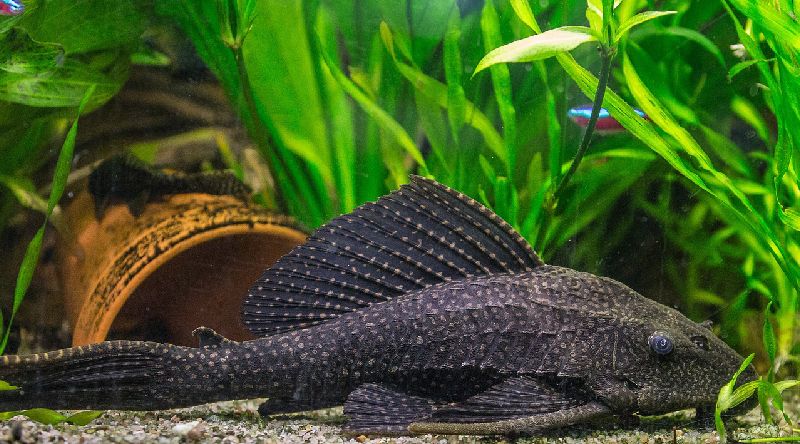
- Size: Up to 24 inches
- Temperature: 72 – 84 degrees Fahrenheit
- Difficulty Level: Easy
Plecostomus, or Pleco, as they are commonly called, are another tank-cleaning scavenger. They’re also catfish, and they come in several varieties. This is why it’s good to make sure you’re getting one that won’t outgrow your tank. A pleco that starts out being only a few inches long could soon grow to be more than 2 feet. The Clown Plecostomus is one variety that stays small into adulthood, making it a particularly suitable choice for a Neon tetra aquarium.
Plecos mostly eat algae around the tank, but might need to be given some additional food to ensure proper nutrition. They can eat cut up vegetables as well as fresh, frozen, or dried animal proteins (like worms and brine shrimp).
Plecos really like to hide. Provide some kind of cave or tube for them to slink into when feeling anti-social. While they’re not super particular about water conditions, it’s best to keep things consistent for Plecos. Once you settle on suitable parameters for your aquarium, try to maintain them. Major or frequent changes can stress out your Plecos and other fish.
Halfbeaks
- Size: 2 – 3 inches long
- Temperature: 75 – 82 degrees Fahrenheit
- Difficulty Level: Easy
Halfbeaks are named for their prominent lower jaw, which protrudes much further than the upper jaw (and it really does look a bit like the bottom half of a bird’s beak). You may also see them referred to as Spipefish or simply Spipe.
There are a few varieties of Halfbeaks that have slightly different requirements so take care to select one that is compatible with your tank conditions.
All Halfbeaks like caves, plants, and other places to duck behind. Technically, Halfbeaks aren’t schoolers. However, they usually do fine in community tanks with other non-aggressive fish. They are jumpers, though, so keep your tank tightly covered.
Natural carnivores, halfbeaks enjoy fresh and frozen brine shrimp or worms. You can also feed them flakes, pellets, and other pre-made foods – just make sure you choose a kind made specifically for carnivorous fish.
Apple Snails
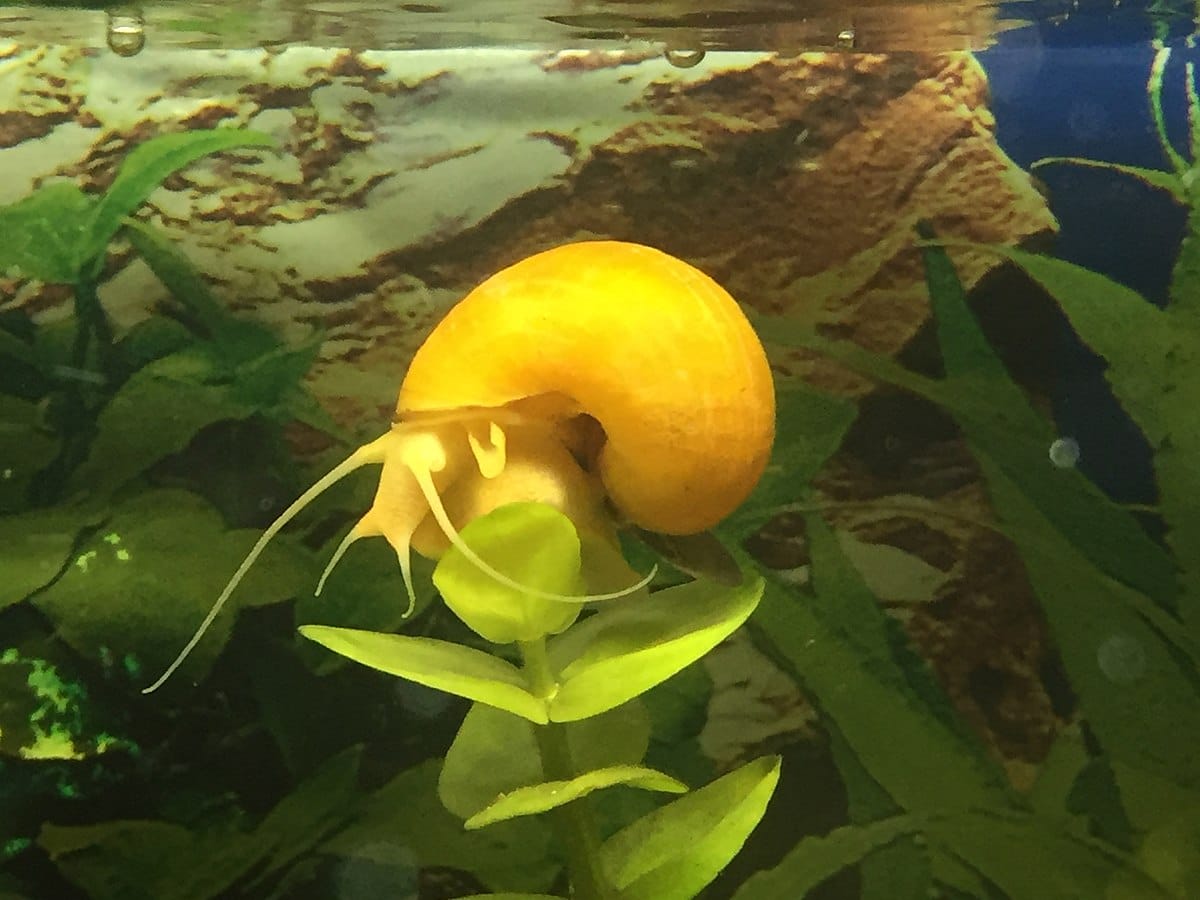
- Size: 1 – 2 inches
- Temperature: 70 – 80 degrees Fahrenheit
- Difficulty Level: Easy
Adding a few snails to your freshwater aquarium is generally a good move. They’re ever so cute, they are inexpensive and require very little care, and they help keep your tank clean by nibbling on the algae and debris.
Apple snails (often called Golden Apple snails) are fairly large compared to other popular aquatic snails, and should only be placed in large tanks so they don’t crowd their neighbors out.
Apple snails get their name from their golden orb of a shell. These snails are beautiful and quite active (for snails, anyway), making them a good choice for someone looking to add variety and visual appeal to their community tank.
Two things about Apple snails, though.
- They breed easily, and they breed profusely. Apple snail populations can quickly get out of control once they start reproducing.
- They eat like they breed. A lot. So be sure to provide ample food for any Apple snail you bring home. Otherwise, they’ll just devour everything in sight – including decorative plants and food meant for their roommates.
Harlequins Rasboras
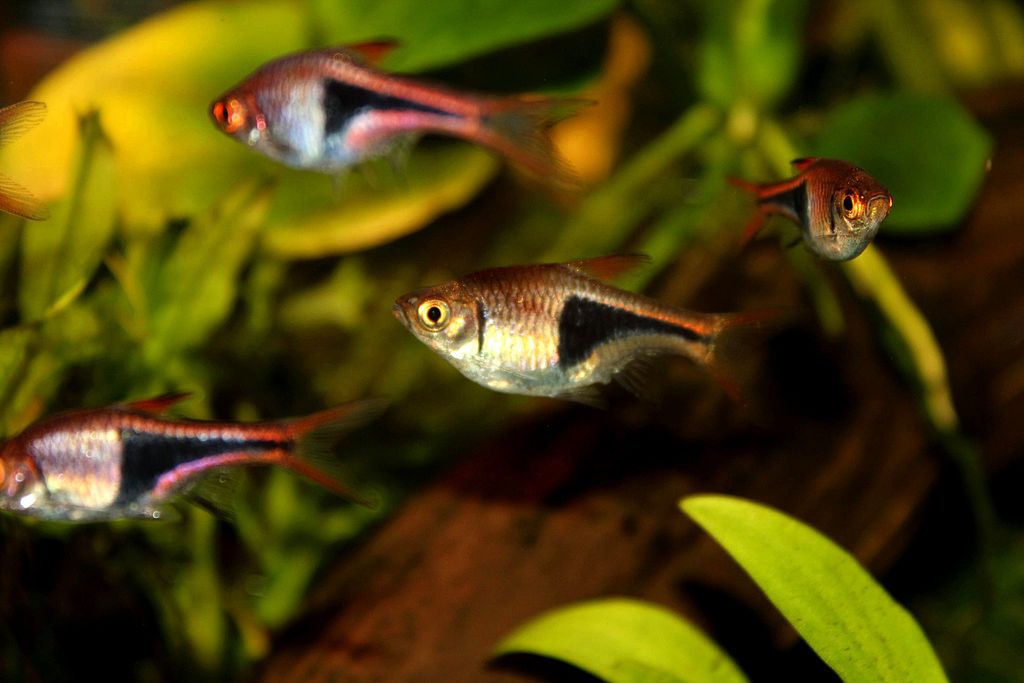
- Size: 1 – 2 inches
- Temperature: 72 – 82 degrees Fahrenheit
- Difficulty Level: Easy
These tiny tankmates won’t give you much trouble, as they are notoriously easy to take care of. They’re not aggressive and tend to keep away from any creatures that are larger or more energetic than they are.
Harlequins are named because of black markings that are reminiscent of a harlequin costume. These marks stand out starkly against the subdued silver, orange, and blue tones usually found on their main body.
The type of substrate you use for Harlequins isn’t as critical as it is with many other types of fish. That’s because they rarely – if ever – visit the lower portions of the tank. They like plants, rocks, and plenty of things to conceal themselves behind or under. Of course, they also need free space to swim without obstructions.
These amicable fish aren’t particularly picky about their diet and will eat all kinds of food. Give them a mix of fresh veggies, flake food, and animal protein such as bloodworms and tubifex worms.
Avoiding Bad Neon Tetra Tank Mates
While plenty of fish make good choices for cohabitating with your Neon tetras, there are some species you shouldn’t even consider. Among them are
- Barbs: Barbs tend to gang up and pick on other fish, nipping at the fins and tails of more ornate creatures such as Angelfish.
- Aggressive cichlids: Species such as Convict, Jack Dempsey, Lemon, Firemouth and Mbuna are all far too combative to live peacefully with Neon tetras.
- Bettas: They don’t call them “fighting fish” for no reason. These antagonistic and territorial fish are not a good match for an aquarium full of docile peacemakers.
- Sharks: Aquarium sharks, including the Red Finned shark and the Rainbow shark, are generally unkind to more passive fish like tetras.
- Piranhas: Keeping piranhas is a whole undertaking in itself. They don’t make good tankmates for just about any other creature.
Generally speaking, just steer clear of placing any aggressive or large aquatic animals with your Neon tetras.
Caring for Neon Tetras
Neons like having vegetation in their habitat, which gives them secret places to hide away from the great big world. Make sure there are few dark corners where your little tetras can sneak off to when they feel like it.
When it comes to food, Neon tetras like a bit of everything. They’ll eat flakes or pellets, as well as dried and frozen worms and brine shrimp.
The type of substrate you use isn’t a huge concern as long as it’s non-toxic and clean, since tetras don’t really hang out on the bottom of the tank anyway. There is one exception to this flexible approach to substrate choices: never use aragonite sand. It’s got calcium carbonate in it, which will throw your water conditions all out of whack.
They like a temperature from about 72-76 degrees Fahrenheit, and a pH around 6-7. It’s important to properly cycle your tank before adding neon tetras. Regular cleaning and maintenance of your aquarium is also critical, as tetras won’t tolerate any nitrite or ammonia in their water.
Varieties of Neon Tetra
Through selective breeding, several interesting Neon Tetra morphs have been created. All have the same water condition requirements; the differences are only in the physical traits they display. Have fun adding whimsy to your tank by mixing it up with a few fun Neon varieties.
Albino: As the name infers, Albino Neon Tetras are virtually colorless. Their pale bodies are almost luminescent, sparkling as they catch the light.
Golden: Goldens are similar to Albinos, though they are technically leucistic. This means that they have low levels of melanin rather than a complete lack of it (like true Albinos). Golden Neon tetras are pale, but often have some red striping and/or a bit of muted blue coloration.
Longfin: It probably won’t take many guesses to figure out how Longfins get its name. They are basically just neon tetras with super long fins. They make a cool-looking addition to your aquarium but watch them around any fin-nipping neighbors.
Green: “Green Neon tetras” really aren’t even neon tetras. However, you’ll likely see them marketed as such, so it makes sense to include them here. They look a lot like Neon tetras, except that where Neons would have blue coloring, the Greens have, of course, green. The red stripe is also smaller than it is on true Neon tetras.
Diamond Head: On a Diamond Head, you trade the signature striping for a striking blue diamond marking.
Tank Tips
Even beginner hobbyists can have amazing home aquariums full of vibrant, thriving aquatic creatures. You just have to set things up the right way, and pay attention to proper care and maintenance. These tips will help ensure your aquarium is a happy and healthy place for all its inhabitants.
- When considering compatible Neon Tetra tank mates, always remember to account for everyone’s preferred water conditions, lighting needs, and so forth.
- Get a tank that is big enough to safely and comfortably accommodate your aquatic community, including rocks, plants, and decor.
- Speaking of tank decorations, ensure that anything you put inside is safe for all the species living there.
- Pay attention to the day/night cycles of your aquarium-dwellers. Nocturnal fish will have different lighting and feeding needs than those that are more active during the day.
- Use the best quality filter you can afford, and make sure it is powerful enough to keep the water in your aquarium sufficiently clean. Inadequate filtration can lead to a buildup of dangerous toxins.
- Clean your tank regularly, and change the water as often as needed to maintain optimum conditions. While many aquatic pets can survive a dirty tank, it’s not ideal and such animals will not live their happiest or longest possible lives. Make sure plants, rocks, other features are safe for all the inhabitants of your aquarium.
- If you plan to breed any of your pets, it’s best to get a separate tank (or tanks) for that purpose. Keep newborn fish, frogs, and other animals away from adult fish so they don’t become an appetizer.
- Keep your tankmates around the same size as one another. It’s advisable not to have just one species that’s substantially larger (or smaller) than everyone else in the aquarium.
- Gravel substrate tends to be a good choice for a peaceful community tank like the one you’re building around your Neon tetras. Just be sure to use a blend that’s small enough to safely pass through tiny digestive systems. Fish and frogs may accidentally ingest a piece of rocky substrate when eating. A large enough pebble could cause impaction, which can be fatal.
- Consider keeping only one type of “scavenger” in the tank. For example: If you decide to add a Pleco, don’t invite any apple snails home with you. This is because these helpful tank-cleaners have such voracious appetites, they can monopolize the food supply in the habitat. It’s not that you can’t keep multiple scavengers, just take care to ensure that everyone is getting enough to eat.


As a Newby to the hobby I would just like to thank you for all the great advice and information.Its been very helpful in the choices I’m making for my new friends 🎏.
I’m starting a fish Aquarium 20 gallons, I have enjoyed reading and learning about small aquariums, And so many small fish that can be put in a 20 gallon tank. Thank you for all the information it has been a great help.